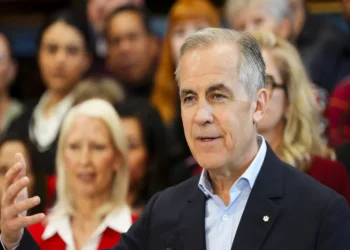Republicans aim to pass the major tax and spending bill through budget reconciliation, a legislative process that allows bills to bypass the filibuster and pass with only a simple majority in the Senate.
Republicans approved a budget resolution earlier this month that includes instructions for reconciliation, the first major step in the projects.
Yet the reconciliation instructions do not commit Republicans to major spending cuts to go along with the tax cuts. The tax cuts amount to roughly $6 trillion over the next decade. In the meantime, the federal government is already on track to run huge deficits over the coming years.
Here’s what to know about the spending cut goals in reconciliation.
Instructions for the House
Republicans hold only a slim majority in the House. Some members favor major spending cuts to lower deficits and the federal debt. To get them on board with the legislation, the budget resolution the House adopted includes floors for various committees to find hundreds of billions of dollars in spending cuts.
The reconciliation instructions for the House include decent-sized spending cut floors. The cuts would come from individual committees that are tasked with writing legislation to spell out reductions in spending through specific programs:
- Committee on Energy and Commerce — $880 billion
- Committee on Education and Workforce — $330 billion
- Committee on Agriculture — $230 billion
- Committee on Oversight — $50 billion
- Committee on Small Business — $10 billion
- Committee on Financial Services — $1 billion
- Committee on Natural Resources — $1 billion
That all adds up to $1.5 trillion, a number that has gotten a lot of play in the media after House Speaker Mike Johnson was able to get the votes to pass the budget resolution.
It is critical to note that $1.5 trillion in spending cuts would only partially offset the tax cuts sought by Republicans, not to mention any additional new spending programs that might be included in the final legislation, such as for border security.
The reconciliation instructions give the tax-writing House Ways and Means Committee up to $4.5 trillion for a net tax cut.
The Bipartisan Policy Center found that if the committees are able to meet the goal of finding $1.5 trillion in spending reductions, the tax cuts and other spending priorities would still add nearly $3.3 trillion to the deficit.
But, in the technical sense, there is no officially identified topline in the resolution identified as $1.5 trillion, according to Michael Thorning, director of BPC’s Structural Democracy Project.
“The way reconciliation is structured is that this is really supposed to be a committee-driven process,” Thorning told the Washington Examiner.
Instructions for the Senate
The reconciliation instructions give the Senate much more wiggle room.
They include floors of just $4 billion — billion, not trillion — in total spending cuts across four committees, compared the $1.5 trillion in the House.
While there are deficit hawks in the Senate, there are also several Republican senators who might oppose significant spending reductions, such as reforms to Medicaid, the health insurance program for low-income and disabled people.
Senate Majority Leader John Thune (R-SD) said that it’s his conference’s “ambition” to find $1.5 trillion in spending cuts. But he has acknowledged the challenges the Senate will face and has noted that some in his conference might see $1.5 trillion in cuts as too much.
“We got folks on both sides of that issue. We’ll have to sort it out,” Thune said, according to the Hill.
The sorts of spending reforms contemplated by fiscal hawks in the House would likely generate pushback from centrist Republicans.
In the House, the Agriculture Committee is tasked with finding $230 billion in spending cuts. Such savings would likely come from the Supplemental Nutrition Assistance Program, or food stamps, which is administered through the Agriculture Department. Many Republicans would blanch at cuts to food stamps, although a majority might vote for measures to tighten work requirements.
Similarly, the reconciliation instructions call for $880 billion in deficit reduction from the House Energy and Commerce Committee, which has jurisdiction over Medicaid. While many conservative Republicans favor sweeping reforms to the program, centrists, such as Susan Collins (R-ME) and Lisa Murkowski (R-AK) have indicated opposition to overhauling Medicaid.
And last week, a dozen House Republicans sent a letter to Johnson vowing not to vote for legislation that includes big cuts to the program, although they acknowledged the need for “targeted reforms.”
“We cannot and will not support a final reconciliation bill that includes any reduction in Medicaid coverage for vulnerable populations,” the lawmakers said.
Republicans do have options to reduce Medicaid spending in ways that they could argue do not reduce benefits for core, vulnerable recipients. For instance, one option is to boost work requirements. According to the Committee for a Responsible Federal Budget, imposing federal work requirements for Medicaid would save the government approximately $140 billion over 10 years. Republicans have suggested the requirements would apply only to able-bodied adults without children.
But the numbers show that getting sufficient spending reductions to offset tax cuts will be very difficult.
Rep. Chip Roy (R-TX) lobbied for steeper spending cuts. But Roy said he “reluctantly voted” for the budget blueprint after Trump and congressional leadership promised “a minimum of $1 trillion in real reductions in mandatory spending” in reconciliation, according to the New York Times.
Brendan Duke, senior director for federal fiscal policy at the Center on Budget and Policy Priorities, a left-of-center think tank, pointed out that the floors are in place to comply with the budget resolution, but they could always change.
“Those committee instructions in the House were not written into the Constitution by James Madison, right?” Duke told the Washington Examiner. “Those were the political price of getting the ball rolling on reconciliation. Individual members of Congress deeply wanted those spending cuts.”
And while the House has the technical ability to change that target, if they did so they could lose the votes of deficit hawks like Roy who would be upset if that level of cuts does not ultimately end up in the final fiscal overhaul legislation.
“The roadblock is not procedural on the House, it’s political,” Duke said.
Roy has said that Johnson had “made a specific commitment to guarantee the House framework tying tax cuts to spending cuts.”
HERE ARE THE MAJOR DILEMMAS FACING THE GOP AS IT WRITES TAX OVERHAUL
And while procedurally the levels of spending cuts can be changed, some Republicans in the House might balk and accuse GOP leadership of backtracking on assurances of the spending cuts.
“So I think you’ve got some deficit hawks, for instance, who the price of their support is that $1.5 trillion number,” Thorning said. “Well at that point, the procedural part doesn’t really matter. You’ve got a political problem.”















